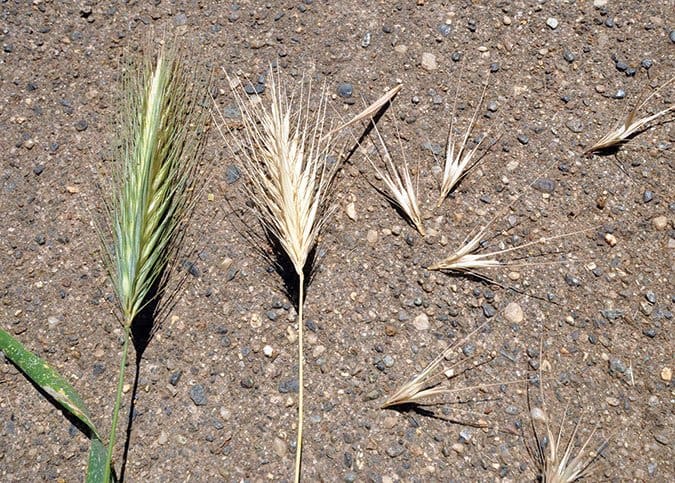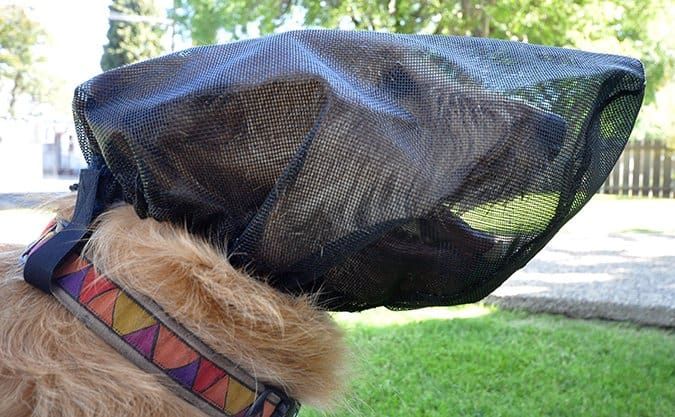In California, where I have spent all but one year of my life (so far) with dogs, there are two types of dog owners: those have spent a small fortune having veterinarians remove foxtails from some part of their dogs’ bodies, and those who haven’t – yet. I’m in the first group, and I would hazard a guess that the first group is far larger than the second.
If you live in the western United States (particularly California), are planning to visit with your dog, or have adopted a dog who spent any time in that part of the country, you should know all the ways that this plant can hurt your dog (and your bank account!). It doesn’t matter if the exposure was recent or months ago. If the dog has been near foxtail grass, read on!

For those lucky folks in eastern North America who ask, “What are foxtails?”:
There are many plants in the grass family, Hordeum genus, that have fox tail-shaped reproductive structures, such as Hordeum brachyantherum (found all over western North America) and Hordeum jubatum (widespread in the United States and Canada). Hordeum murinum and Hordeum marinum (which appear across most of the western U.S.), though, are the grass species that cause the most harm to dogs (and other animals). Only botanists refer to these grasses by their scientific names, however; mostly, the grass is called by the common and descriptive name of its reproductive structure: foxtails, or foxtail grass.
Foxtail grass isn’t present only in California, but the state is definitely ground zero for this injurious plant. It grows as well in pastures and lawns as it does in gravel driveways and cracks in the sidewalk. The seeds geminate in winter, and when the plant starts to grow in the late winter and early spring, it’s actually lovely; it’s a bright green, soft, fast-growing grass that many dogs find irresistible for chewing. As it begins to mature in mid-spring, it produces the structure that resembles a fox’s tail: a thick, bristly spike that starts out green and soft. As spring temperatures increase and the rains end, the grass begins to dry out and the spikes turn yellow. The drier they get, the more brittle they become, and the plume-like “foxtail” starts to fall apart into individual segments, each tipped by a sharp seed and trailing those propulsive awns.
Our dogs and other animals carry the seeds far from the plants that shed them, helping spread them far and wide, but the journey of some seeds into our dogs has no purpose of propagation. The real purpose of the awns is to help the seeds work their way into the soil, where they bury themselves and wait for winter rainfall to germinate and start the cycle again.
Foxtails Are Designed to Penetrate Anything
The seeds of this nasty grass seem to have a special affinity for invading dogs’ bodies. The three most common hazards are these: They get sniffed into dog noses, work their way into dog ears, and lodge between dog toes. Each of these sites is a mere port of entry for these sturdy seeds; once inside, they start a relentless crawl forward, traveling deeper into a dog’s tissue with every passing hour. They are sometimes found in exploratory surgeries years afterward; the durable seed and awn fibers resist breaking down in the body as if they were made of plastic.
Those common jumping-off points for the foxtail’s inner-dog journey are not the only ones, however. Foxtails can penetrate any part of your dog; all they need is a place to attach. In dogs with very short hair (like American Pit Bull Terriers, Vizslas, and Weimaraners), they need a fold in the skin of some kind (armpit, vagina, prepuce). To these bristly seeds, longer, thicker, or curly coats behave a little like the “loop” side of a Velcro-type hook-and-loop fastener; a foxtail can stick to the coat, and wherever it sticks, it will start to burrow, enabling the seeds to penetrate anywhere on the furry dogs’ bodies.
How do they do that?! The seeds are very hard and tipped with a sharp point that is capable of puncturing your dog’s skin and entering his body. Attached to the seed are long, fibrous awns, which are covered with microscopic bristles that are arranged in a single direction, like the teeth on a rasp or nail file. Any contact with these tiny bristles literally pushes the seed forward, trailing its awn behind it.

If you push one of these seeds between your fingers, and then try to pull it out backward, you will begin to understand how they can pierce a dog’s skin and begin to forge, arrow-like, in the dog’s body: It’s very difficult to pull the seed backward, against the “grain” of the tiny bristles. If you pull on the seeds (and awns) when they’re fully dried and brittle (which occurs in late spring), the awn tends to break off (sort of like a captured lizard’s tail). This frees the remaining parts of the foxtail, which continues its singularly forward travel with every movement of the dog.
If a foxtail incursion is detected immediately, they can usually be removed from the dog relatively quickly and easily. Once, I was taking an after-work walk with a good friend and our (combined) four dogs when I noticed that, after urinating and then standing up, her spayed Kelpie, Chaco, had a few drops of blood dripping from her vulva. My friend and I looked at each other and simultaneously said two words that start with the letter F, one of which was “Foxtail!”
We immediately turned around and quickened our pace in an effort to get back to my car and get to the closest veterinary clinic before it closed. The vet was able to use a speculum and alligator retractor and remove the foxtail from Chaco’s vagina within two minutes; she spent a few more minutes making sure that not even a tiny segment of awn was left behind. The bill was less than $100.
I hate to think of what would have happened if we had not happened to see the couple of drops of blood that tipped us off to the foxtail invasion of poor Chaco’s nether end. Had it spent another day or two working its way into Chaco’s vagina, it surely would have caused infection and localized tissue damage, and could have easily traveled anywhere else in her abdomen. Radiographs, ultrasound, and exploratory surgery to find it later would have costs thousands.
The take-home point: If your dog has been anywhere near foxtails, and has any sort of abnormal sign of discomfort or irritation – shaking her head, an uncharacteristic squint, repetitively licking her paw or other part of her body, sneezing, coughing, gagging – call your vet and make an appointment as soon as possible.
Foxtail Dog Damage Horror Stories
Twice in as many years, I’ve seen one of the puppies that I was fostering pawing at his or her face and found and removed a foxtail that had just gotten lodged under the pup’s eyelid. Each time, I thanked my stars that I was right there when it happened and that I noticed the puppy’s discomfort right away.
I’m even more grateful for this now, since I asked friends and followers of WDJ’s Facebook page for foxtail horror stories and was told by two different people that their dog had to have an eye surgically removed after being damaged by a foxtail. ACK!
I’m going to share more anecdotes from people who responded to my request for their “worst foxtail story” – not for the shock value, but so you can be alert to the variety of ways that these freaky seeds can invade your dog and wreak havoc:
- “I know someone who lost two of her working dogs to foxtails in one year. One of them ended up with a foxtail in his lungs; the other was female and the foxtail entered through her vagina and into internal organs.”
- “One of our dogs started coughing up specks of blood. We had to have her ‘scoped (with the dog fully anesthetized, an endoscopic camera is passed down the dog’s throat and into the lungs). The vet found a foxtail lodged in the lining of our dog’s lung and extracted it. That was the most expensive video we ever bought!”
- “My Belgian Sheepdog, Bing, got one in his throat. His airway partially closed. It took an emergency trip to our local vet and then an emergency trip to Penn Vet and an entire team of specialists to do exploratory surgery. Four weeks of prednisone and antibiotics followed. Treatment was particularly challenging because he was a biter, so no evaluations could be done with him awake. The event was a total life-changer for him, and not in a good way.”
- “At one time I owned a Redbone hound who got a foxtail between her toes that quickly moved up her leg. The vet operated but could not find the foxtail. A month latter she abscessed on her side and the vet operated again, and again he couldn’t find it. She had two more surgeries with no luck. I couldn’t afford more operations even though she was a good hunting dog and valuable. I gave her to a man who had her operated on two more times and finally got the foxtail. The dog recovered but was covered with scars. The one foxtail cost thousands of dollars and over a year to take care of.”
- “My one-year-old Golden inhaled a foxtail that traveled through her lung and created an infection in the space next to her heart. She needed open heart surgery to remove the mass and part of her lung. The cost was more than $10,000. Although she nearly died several times that month, she recovered completely. Unfortunately, the scar tissue weakened her heart over time and eventually caused its failure at just eight years old.
- “Teala was my heart and soul. She was the first dog I ever purchased insurance for, back in 2008. Because of this experience, I have sworn to always keep all of my dogs on medical insurance for their entire lives. I never want to have to make a medical or emotional decision because of finances.”
- “When Bailey was just a puppy, she got a couple in her paws and one in her ear the first summer we moved to California from Texas. Foxtails don’t exist in Texas, and we had absolutely no idea whatsoever that they were a hazard – and our backyard was full of them! Now we pull em like crazy, and they are all but gone from the yard.”
Foxtail Hazard Reduction
In the stories above, you may have gleaned a few helpful hints about how to reduce the odds that your dog will be invaded by one of these evil awns – and if she is, what you should do. Here are more:
■ If you walk or hike in foxtail country, consider the only effective protective gear made to prevent the awns from being swallowed, sniffed, or lodged in your dog’s ears: the Outfox Field Guard. This is essentially a net that your dog wears over his whole head. He can see through it, pant, drink, and even carry toys while wearing it, but he can’t get a foxtail anywhere on his face while wearing it.
■ Check your dog after every exposure to the weeds, especially between his toes. If he has the kind of coat that attracts foxtails, brush or comb him thoroughly, daily.
■ Pull up the foxtail plant by the roots as soon as it begins to produce its signature plumes in the spring. Before the plumes appear, it’s hard to tell which grass is foxtail grass and which is not. Dispose of the whole plants in your yard-waste bin or bag them securely and send them to the landfill. The seeds often survive even intense composting; I wouldn’t even try it.
■ Don’t use a string trimmer on them if you can help it. String trimmers actually help disperse the seeds widely.
■ If you must mow the grass, use a grass-catcher and dispose of the clippings in the manner described above. But understand that as long as there is any moisture in the ground and the plant is still alive, after mowing, it will begin to produce the plumes right at ground level.
■ I have heard reports that a propane-torch “weed burner” can help control the weeds. I just bought one. I will get back to you on its efficacy. I can’t wait to go burn some foxtails. I might be happy to burn them even if it doesn’t help me control their population on my property.
■ I HATE to ever recommend the use of Roundup or any other type of herbicide…But we know people who could not eliminate foxtail grass from their property any other way. If you haven’t been able to prevent your dog from getting foxtails in his body every year and the grass is all over your property, we wouldn’t blame you for resorting to this.
■ It bears repeating: If your dog exhibits any sign or abnormal behavior after being exposed to foxtails, go to a veterinary clinic. Of particular note: excessive blinking or pawing at the eyes, sneezing, coughing, gagging, head-shaking, paw-licking (or any targeted licking, especially if you see a raw, red bump), or pain or discomfort while or after urinating.
■ Maintain a health savings account or health insurance for your dog. If you live in foxtail country, whether you have them in your yard or encounter them on your dog walks, you should be prepared to pay for an expensive vet visit or three at some point.
Nancy Kerns is WDJ’s editor.







Any updates on the propane torch method?
Eric, thanks for asking. The weed-burner works well to kill weeds. The biggest problem is that the brief window of time between the time that the plants mature enough so that you KNOW they are foxtails, and when the area dries out enough that it’s unsafe to burn grass. It’s most effective (and highly satisfying) to use on dried-up plants. On green plants, it takes one pass to kill the weed, and another pass a few days later to destroy the now-dead and drying plant to eliminate the foxtail awns. I have been using the weed burner this spring (on days with no wind) on my gravel driveway, where dried plants burn quickly and quickly extinguish shortly after the propane-flame passes over them. It’s super effective in this application. To kill the green plants, with young foxtail awns all over them, you have to keep the flame directed on the green weeds for several long seconds to damage the plant enough to kill it. It would be far too time-consuming to kill all the foxtail plants on my property while the plants are green; I would be out there daily for weeks! Ad if I waited until the whole field has dried up and turned brown (East Coasters: this is what happens naturally in California in the summer), it would be potentially too dangerous to be out there with the propane torch burning grass, even on still days and with a hose close by. You don’t want to be the person on the news who set the neighborhood on fire! So, I’m glad I bought it; I will definitely continue to use it on my driveway and edges of fence lines. But it’s not a total answer for my property.
I have seen a fairly expensive kit offered with the propane tank and a dolly that carries it around and the hose/flame wand/regulator all together. I bought just the hose/wand/regulator and used the propane tank from my gas BBQ and a dolly we already had. The wand kit was about $99.
We are visiting Hill Country in Texas and have been pulling these sharp fox tails off our Golden Retriever for the past few days. So California is not the only state with this issue. Thank you for this informative article.
WTH?!?!?!? Why is round up even referenced in a whole dog journal article?!?!? EXTREMELY disappointed by this loose “no one would blame you” suggestion! Well I sure would blame you! Shame on anyone who reaches for a bottle of this well known toxic poison to use on anything anywhere on our planet. Ugh! You just lost my support!
I live in Ireland and we do have grasses similar to Foxtail. I keep Irish Water Spaniels who have rather large splayed feet. Between their moist toes they used to regularly get these seeds and if not immediately removed they caused havoc. One young bitch was unfortunate to have one travelle up to her body ended up with horrific allergie and had to be destroyed l was heart broken.
As for Round Up it is freely available for sale. Someone used it all over my garden and my beautiful little hedgehog family were destroyed rolling around in agony in pain it was terrible. I rushed them to my vet but nothing could be done. Thousands of frogs were killed aswell.
I eventually sold my home as l could not bear to see nature diminish so fast, Louisa Feb’21
Well some people may not have a choice . Either they use it or their dog gets infected or even dies . I think I think I would choose my dogs life first and foremost. Once under control don’t have to use it anymore but to allow an animal to suffer because you don’t like chemicals is wrong .
What regions of the United States have fox tails? We are in NC & thought we saw some in Western NC while hiking. Thank you
Please! NO Roundup or anything like it! Foxtails are horrible but the damage that pesticides will inevitably cause is a whole other horror show.
Please AVOID Roundup or similar product on foxtails! Our experience when my husband sprayed our large area of foxtail grass some years ago was that the grass part died within a day, but the seed heads continued to develop and dry out FAST, dispersing the seeds within a several days. We tried raking and even vacuuming the seeds, but the following year the sprayed area had a healthy crop of foxtails! Now every spring I pull or dig out as many foxtails grass plants as possible to shrink that foxtail area.
All plants have leaves that have a distinct shape or pattern. My suggestion would be to learn to recognize the leaves of this type of grass. Then you could get rid of it before the foxtails emerge. By the way, we definitely have them here in Colorado where I live, and as a retired CVT I have removed quite a few of these from dogs, especially those with long hair like huskies. They are just like porcupine quills in that they only travel in one direction, they don’t disintegrate and can be found years later.
I live in lreland and have kept lrish Water Spaniels for years.
Living on Dublin mountains these grass seeds destroyed one of my IWS’s. They have very webbed feet which can contain a lot of moisture. We were always pulling them out from between their toes. One broke off and travelled up her leg. Vet opened the whole side of her leg but could not retrieve it. Eventually she lost all of her coat. Her eyes would close up and face would swell up. Eventually poor Molly had to be put asleep at barely 2yrs old. We were devastated. Louisa Dublin Mountains.
My yard is plagued with foxtails. I take a pointed shovel and find the base of the plant and a quick jab and pop out the entire plant. I have spent hours and hours and hours doing this. The key is to know the plant and get them out before the seeds dry. When green the seeds all stay together and can easily be removed. Once the seeds are dry (brown) if you remove the plant – the seeds will go every which way. I call them the bastard weeds.
Excellent article, very informative. Thank you.